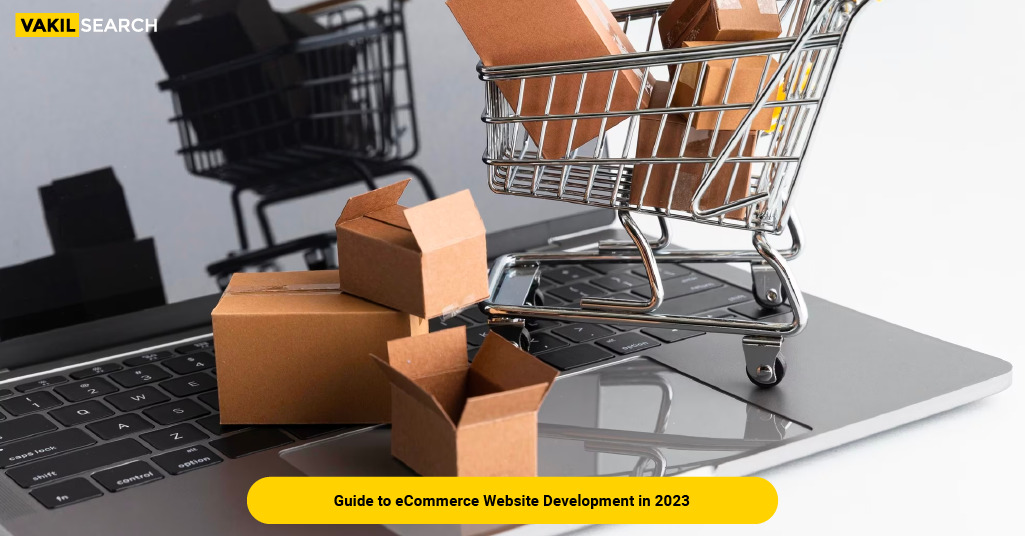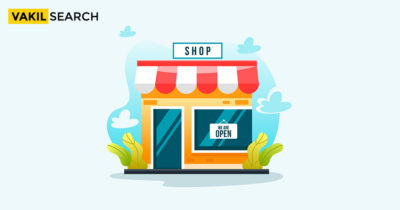Learn about developing e-commerce websites and how to build an online marketplace for buying and selling goods and services. Know the tips and tricks from the experts at Vakilsearch.
Guide to eCommerce Website Development
While developing an e-commerce website, you must build both the front end and the back end of your online store, which entails developing product pages, shopping carts, order forms, and support pages as part of the build strategy. Make sure that the user interface is the best. It is the procedure for making your e-commerce website operational! E-commerce website development is all about giving your customers a seamless and user-friendly experience from product browsing to making purchases, whether you want to offer goods or services online. Almost 15% of purchases are made online as online retail slowly but surely overtakes traditional retail worldwide. Guide to eCommerce Website Development is necessary if you want your small business to participate in the growing trend that this number represents.
A well-designed e-commerce website is more than just attractive on the surface. If carried out correctly, it will result in actual sales and profits for your small business by optimising the consumer ordering procedure and creating brand equity that can sustain your enterprise.
Why is E-commerce Web Development Important?
E-commerce web development is crucial in the current business environment because it gives companies a simple and secure platform to sell their goods and services online. E-commerce has become a key role in generating sales and revenue for companies of all sizes with the rise in internet and mobile device use.
- Website development for e-commerce is essential in today’s business environment.
- It enables companies to access new markets and a larger audience.
- Customers that shop online benefit from the convenience and smooth purchasing experience.
- Platforms for e-commerce offer a secure environment for online transactions.
- Businesses may manage their online marketing and sales activities with the aid of e-commerce tools and services.
- E-commerce web development is crucial for companies trying to thrive in the online market.
The 6-Step E-commerce Web Development Process
- Planning and research are the first steps in building an e-commerce website. This entails identifying the company’s goals, its target market, and its rivals. A solid framework for the e-commerce website can be built by researching market trends, and client preferences, and determining the unique selling proposition (USP).
- An engaging user experience is greatly influenced by the way an e-commerce website is designed. It is crucial to pick a design that complements the brand identity and resonates with the intended audience. The layout must be responsive, straightforward, and simple to use. To build a visually appealing design that serves the intended purposes, working with a qualified web designer is advised.
- The e-commerce website is built during the development phase using the most recent technology and programming languages. Making sure the website is optimised for speed, security, and performance is crucial. To guarantee that it is accessible to all users, the website should be tested across a variety of platforms and browsers.
- Any e-commerce website needs to have content. High-quality product descriptions, photos, and videos are crucial for effectively showcasing goods and services. The material must reflect the language and tone of the brand and be search engine optimised.
- The process of developing an e-commerce website must include this phase. It is crucial to pick a trustworthy payment processor that offers customers a smooth checkout process. The payment gateway needs to work with the website and be safe, convenient, and user-friendly.
- Testing and launching the website is the last step in the construction of an e-commerce website. To find and correct any faults or problems, comprehensive testing is crucial. The website shouldn’t be made public until all problems have been fixed and it is ready to offer users a flawless experience.
3-Point Ecommerce Web Development Checklist
User Experience (UX) Design: The first step in developing an e-commerce website is to focus on creating a great user experience for your customers. This includes designing a user-friendly interface, easy navigation, and responsive design that works well on different devices. You should also ensure that your website loads quickly has clear and concise product descriptions and has an easy checkout process.
Payment Gateway Integration: A payment gateway is an essential component of any e-commerce website as it enables customers to make secure online payments. Ensure that your website supports multiple payment options, such as credit cards, debit cards, net banking, digital wallets, and other payment gateways like PayPal. You should also ensure that your payment gateway is secure and complies with PCI-DSS (Payment Card Industry Data Security Standards) guidelines.
Search Engine Optimisation (SEO): Once your e-commerce website is up and running, you need to ensure that your website ranks well in search engines like Google. This involves optimising your website’s content, keywords, meta tags, and images, and creating backlinks from reputable websites. You should also ensure that your website has a sitemap and is mobile-friendly as these factors can affect your website’s search engine rankings.
Qualities of Successful E-commerce Sites
There are various characteristics that successful e-commerce sites have in common that make them successful. These factors consist of:
- E-commerce websites must have a user-friendly design. Users should have little trouble navigating the website and discovering the things they’re looking for.
- To assist customers in making knowledgeable buying decisions, clear and detailed product information, including descriptions, photos, and specifications, is crucial.
- E-commerce websites must have secure payment processing systems in order to safeguard the financial and personal data of their users.
- The performance of a quick and dependable website is essential for retaining clients and preventing them from leaving because of poor load times or website breakdowns.
- As more and more clients shop online using their mobile devices, e-commerce websites must be mobile-friendly.
- An efficient and user-friendly checkout procedure can assist lower cart abandonment rates and boost conversion rates.
- For e-commerce sites, strong customer service is crucial. If customers have any inquiries or issues, customer service should be simple to reach.
FAQs About Ecommerce Web Development
What are e-commerce websites?
E-commerce websites are digital platforms that let companies sell goods and services to clients online.
What are the types of e-commerce websites?
Business-to-consumer (B2C), business-to-business (B2B), consumer-to-consumer (C2C), and consumer-to-business (C2B) websites are examples of e-commerce websites.
What does an e-commerce web developer do?
An e-commerce web developer designs, codes, and implements payment systems in order to construct and maintain online stores that make it easier for people to buy and sell goods and services.
Conclusion
To sum up, eCommerce is a constantly changing environment that necessitates a deliberate approach to website creation. Businesses may use eCommerce to expand their reach, boost sales, and get an edge over rivals if they take the correct strategy. Vakilsearch’s team of professionals is committed to assisting companies in thriving in this fast-paced environment because we are aware of the special opportunities and problems associated with developing eCommerce websites. We can assist you whether you’re just getting started or hoping to grow your eCommerce company in 2023.
Other Important Topics:










